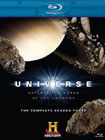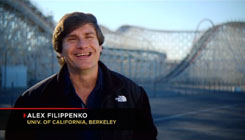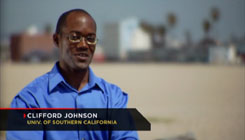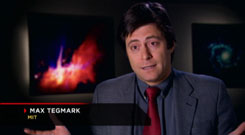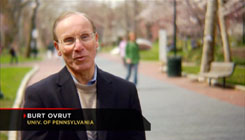This episode takes its time to go over the "4 levels" of alternate universe types,
although graphic headings in the style of the
"Wildest Weather in the Cosmos" or
"7 Wonders of the Solar System" episodes
probably would have helped quite nicely.
Personally, I think the interviews on
the short featurette
"E-Space - Fact or Fiction?" on the DVD for
"Full Circle"
covered the topic and the four levels with greater clarity,
although after having seen that as a "primer", the extra detail in this episode
of "The Universe" allows us to take some concepts further and see what's
behind them.
Support for Level 1 universes comes in part from
detail of the shape of our universe as discovered by the WMAP probe,
(Wilkinson Microwave Anisotropy Probe), although after seeing this several times,
I still have no idea how it obtains the angular information necessary for its
triangular calculations.
The episode more deeply explores applications of 11 Dimensional String-theory and
Membrane-theory (M-theory) in spawning new bubble universes,
and sees Alex Filippenko kayaking on an ocean surface that represents a membrane.
Lots of good stuff here, but it makes you feel like there's a lot more detail
that the episode won't have time to cover. Interesting additional material
would be
Dr. Bruce Lipton's lectures.
His material on the biological similarities between skin and the brain,
coupled with biochemical mechanisms for intelligence, awareness, and choice,
make a VERY interesting comparison with interaction between universes and membranes.
My favourite bits predictably are those concerning
the quantum physics behind Level 3 alternate history universes,
which are easily the most likely to have copies of our solar system
and all of us. I'm not sure why this idea was first introduced during
the Level 1 segments, but thankfully it is expanded on quite nicely
for the Level 3 segments where it properly belongs.
Joe Lykken:
"So, every historical event actually happened
in every possible way in some branch of this
ever-splitting many-worlds universe."
Michio Kaku:
"The universe, at one point, was actually smaller
than an electron.
If that's true and if electrons are described
by being many places at the same time in parallel states,
this means that the universe also exists in parallel states.
You inevitably get parallel universes."
Only brief mention is made of the random physics of fourth level universes.
The focus shifts to Fermi Laboratories, where Joe Lykken goes over the details
of the experiments underway to hopefully prove the existence of these other
universes.
The last segment here touches on the Einstein-Rosen wormhole bridge, and postulates the
possibility of travel to these other universes - basically presenting the
familiar premise of the TV series "Sliders"
from a scientific point of view and giving meaning to a lot of the phrases
often heard there. I'd bet Michio Kaku is a fan of that show
(as he has been of Doctor Who).
from the disc sleeve:
Parallel Universes:
Previously considered the stuff of science fiction, some of today's leading physicists are
uncovering evidence showing what they believe are universes other than our own. Do these
higher dimensions exist, and if so, how will our lives, planet and science change upon their
discovery?
Take this description with a grain of salt though, because the episode doesn't seem to examine
social impact with any depth (personally, I don't see how such a discovery will
change anything, because really, how many of us in our day-to-day lives are invested in
there NOT being other universes out there somewhere? ...Maybe only a few scientists with
their heads buried in institutionalized thinking. The rest of us will carry on as usual
and be fine.)
Chapter List:
- Introduction
- Multiple Universes
- Cosmic Bubbles
- Other Dimensions
- Evidence
- Travel Between Universes
|
Participants include:
|
